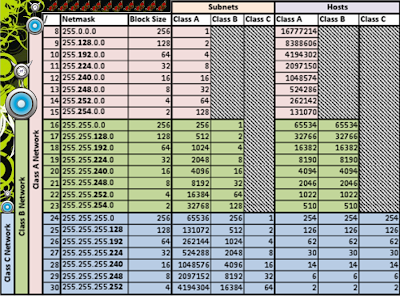

Therefore, the network address is going to go up in multiples of 16. 2 to the power of 20 works out a little over one million subnets.įor the IP address, 60.15.10.75/28, what are the network address, the broadcast address, and the range of valid IP addresses?įor this example, the line is after the 16 when we draw it out. We have 20 bits for the network addresses which is the difference between the default /8 and the /28 that we're using. So, that's 2 to the power of 4 equals 16 minus 2 and it gives us 14 hosts per network. We put the line in after 16, and we can see that we've got 4 bits for our host addressing. We were given a dotted decimal 255.255.255.240, which is the same as a subnet mask of /28. If we apply with the subnet mask 255.255.255.240, how many subnets do we have, and how many hosts per network? In this example, we'll do a Class A where we're going to subnet on the fourth octet. Then, we add 8 to the 136 to get the 144 and we know that that is the next address block. We find which block of 8 is closest to that, which is 136. In that example, our address was 135.15.10.138. 256 minus 248 gives you 8, and now you know that the network addresses are going to go up in blocks of 8. So 248 in this case, you take that away from 256. What you do with the magic number is you take the value in the octet that is being subnetted.

So a /29, if we wrote that out in dotted decimal notation it's 255.255.255.248. This one is very handy if you've been given the subnet mask in dotted decimal notation rather than with a slash. You'll see this being cited in quite a few places on the internet. So that's 135.15.10.137 up to 135.15.10.142.Īnother popular way of calculating the network address, the broadcast address, and the host addresses is by using the magic number method. The valid addresses for our hosts fall between the network address and the broadcast address. Now, if the next network address is 144, then the broadcast address is 135.15.10.143.

The next network address would be 135.15.10.144. The line is after the 8, so we add 8 to 136 and that is 144.

We add those two together which is equal to 136. In the top right, we've got ones under 128 and 8. We're putting a line after the /29 and the line is going in after the 8. We've got the IP address and the subnet mask.
#Youtube.com subnet mask table plus#
5 plus 8 gives us 13 bits and 2 to the power of 13 is going to allow a total of 8,192 subnets.įor the IP address, 135.15.10.138/29, what would be the network address, the broadcast address, and the range of valid IP addresses? It would give us 5 bits but since it is Class B, we've got those extra 8 bits. If it was a Class C, we would only have 5 bits for the network address because 29 minus 24 has a difference of 5. In a Class B /16 range we're going to have 13 bits for the network address. So, a /29 will give us 6 available hosts per network even if we're using a Class A, B, or C. This will allow us 6 hosts per network because 2 to the power of 3 is equal to 8 minus 2 gives us 6 hosts. We've got 32 bits in the address, 32 minus 29 gives us our 3 bits. If we subnet that into /29 subnets, we're going to have 3 bits for host addressing. 00 00 00 00 00 00 00 e0 isatap.For our first example, we've been allocated a Class B network with an IP address of 135.15.0.0/16.
#Youtube.com subnet mask table windows#
Here's an example from a typical Windows client computer: C:\>route printĨ. The output displayed by the Windows and Unix/Linux commandsĪre similar. In Unix/Linux, you can just use route without any command To display the routing table (both IPv4 and IPv6) in Windows, use the route The routing table properly is a key part of configuring a router to work. Use the route command to make sure that a bad entry in the computer'sįor a computer with more than one interface and that's configured to workĪs a router, the routing table is often a major source of trouble. You're having trouble accessing other computers or other networks, you can Is pretty simple and isn't often the source of network problems. For a typical computer that has a single network interface and isĬonnected to a local area network (LAN) that has a router, the routing table Using the route command displays or modifies the computer's routing


 0 kommentar(er)
0 kommentar(er)
